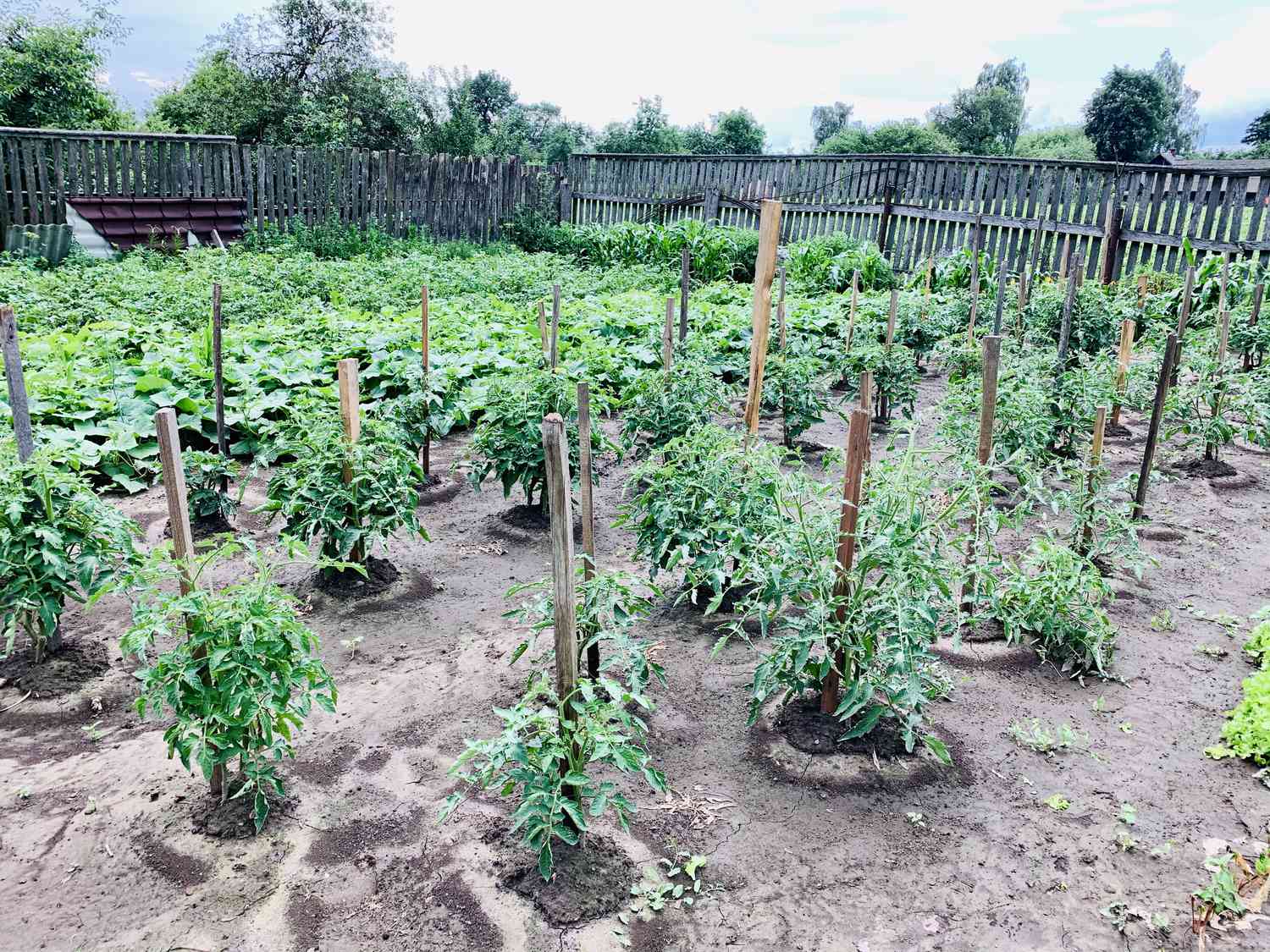Tomatoes are a beloved staple in many home gardens, and achieving a bountiful harvest requires careful consideration of various factors, including soil quality, sunlight, and water. One crucial aspect that often determines the success of your tomato plants is the spacing between them.
The right spacing not only promotes healthier growth but also helps prevent diseases and allows for proper air circulation. In this article, we’ll explore the importance of proper spacing for tomato plants and provide guidelines on how far apart to plant them for optimal results.
Table of contents
Why Does Spacing Matter?
Spacing in tomato plants matters for several important reasons, all of which contribute to the overall health, growth, and productivity of the plants. Here are the key reasons spacing is crucial in tomato cultivation.
- Air Circulation: Adequate spacing allows for better air circulation between tomato plants. Good airflow is essential for reducing humidity around the plants, which helps prevent the development and spread of fungal diseases.
- Disease Prevention: Tomatoes are prone to various diseases, and many of these thrive in conditions of high moisture and poor air circulation. When plants are too close together, the foliage traps moisture, creating an environment conducive to diseases such as early blight and late blight.
- Sunlight Accessibility: Tomatoes are sun-loving plants that require ample sunlight for photosynthesis and fruit development. Insufficient sunlight can lead to reduced yields and slower ripening.
- Nutrient Absorption: Tomatoes have extensive root systems that need access to nutrients in the soil. When plants are too close together, competition for nutrients becomes intense, potentially leading to nutrient deficiencies and stunted growth.
- Preventing Overcrowding: Proper spacing prevents overcrowding, ensuring that each plant has enough space to grow without being hindered by neighboring plants.
Types of Tomatoes
Tomatoes come in a wide variety of shapes, sizes, colors, and flavors. The diverse array of tomato types allows gardeners and consumers to choose varieties that suit their preferences, culinary needs, and growing conditions.
Here are some common types of tomatoes.
- Cherry Tomatoes: Cherry tomatoes are small, round, and typically sweet. They come in various colors, including red, yellow, orange, and even purple.
- Grape Tomatoes: Similar to cherry tomatoes, grape tomatoes are small and oval-shaped. They are known for their firm texture and sweet taste.
- Roma Tomatoes: Also known as plum tomatoes, Roma tomatoes are oval-shaped and have fewer seeds and thicker flesh than many other varieties. They are often used for making sauces, pastes, and canning.
- Heirloom Tomatoes: Heirloom tomatoes are open-pollinated varieties that have been passed down through generations. They come in a range of colors, shapes, and flavors, often with unique and distinctive characteristics.
- Plum Tomatoes: Plum tomatoes are elongated and have fewer seeds and denser flesh than round tomatoes.
- Determinate Tomatoes: Determinate tomatoes are compact and have a defined growth pattern. They produce a concentrated set of fruit over a short period, making them suitable for smaller spaces and container gardening.
- Indeterminate Tomatoes: Indeterminate tomatoes continue to grow and produce fruit throughout the growing season. They often require staking or caging for support.
See this: How Long Do Goldfish Live: Aquatic Lifespan Understanding
How Far Apart to Plant Tomatoes
The spacing of tomatoes is contingent upon the tomato types and the support systems employed. For dwarf determinate tomatoes, which have a height of 12 to 18 inches, plant them one to two feet apart. Larger determinate tomatoes should be spaced at two feet intervals.
Indeterminate tomatoes, on the other hand, necessitate strategic spacing, especially when using support. Staked indeterminate tomato plants are ideally placed 18 to 24 inches apart. These plants are routinely pruned for controlled growth and improved air circulation.
If you let your indeterminate tomatoes sprawl without staking, a spacing of three to four feet between plants is recommended. This flexibility in spacing accommodates different growth habits and support preferences, contributing to healthier and more productive tomato plants.
Read: How to Pronounce Quinoa: Culinary Fluency in Healthy Eating
How Long Does it take for Tomatoes to Grow?
The time it takes for tomatoes to grow and mature varies depending on several factors, including the tomato variety, growing conditions, and whether you’re starting from seeds or transplants.
Here’s a general timeline for the growth of tomatoes:
From Seed to Seedling
If you’re starting tomatoes from seeds indoors, the germination process typically takes about 5 to 10 days. After germination, the seedlings will continue to grow for several weeks before they are ready to be transplanted.
Transplanting Seedlings
Tomato seedlings are usually transplanted into the garden or larger containers when they have developed two sets of true leaves. This typically occurs around 5 to 7 weeks after germination. Transplanting is often done after the last expected frost date in your area.
Vegetative Growth
Once transplanted, tomato plants go through a period of vegetative growth where they develop more leaves and establish a robust root system. This phase can last for several weeks, depending on the growing conditions and the specific tomato variety.
Flowering Stage
Tomato plants typically start flowering around 6 to 8 weeks after transplanting. The timing may vary based on factors such as temperature and light conditions. Flowers are indicators that your tomatoes are about to bear fruit.
Fruit Development
The time it takes for tomatoes to grow from flowers to mature fruit depends on the type of tomato. Determinate varieties produce fruit over a relatively short period, often within 70 to 85 days from transplanting.
Ripening
After the fruit has formed, the time it takes for tomatoes to ripen depends on factors such as temperature and sunlight. Generally, it takes about 20 to 30 days for tomatoes to reach full maturity and become ready for harvest.
Related: How Many Bottles in a Case of Wine: Social Savvy in Wine Collection
FAQs
Rows of determinate tomatoes should be spaced around 24 to 36 inches apart. This spacing ensures adequate air circulation and facilitates maintenance activities.
Staked indeterminate tomato plants are ideally spaced 18 to 24 inches apart. This spacing allows for controlled growth and effective air circulation.
Leave enough space between rows (24 to 48 inches) to ensure easy access for watering, weeding, and harvesting. Adequate spacing facilitates comfortable movement and maintenance activities.
Conclusion
Achieving a successful tomato harvest requires attention to detail, and proper spacing is a key factor in ensuring the health and productivity of your plants. By providing adequate space, you create an environment that promotes air circulation, sunlight accessibility, and nutrient absorption.
These factors contribute to disease prevention, robust growth, and a bountiful harvest. So, the next time you embark on your tomato gardening journey, remember to give your plants the space they need to flourish and reward you with a bumper crop of delicious tomatoes.
References
- Savvygardening.com – How far apart to plant tomatoes
- Southernliving.com – Everything You Need To Know About Tomato Plant Spacing
- Gardeningknowhow.com – Spacing Tomato Plants: How To Space Tomato Plants






